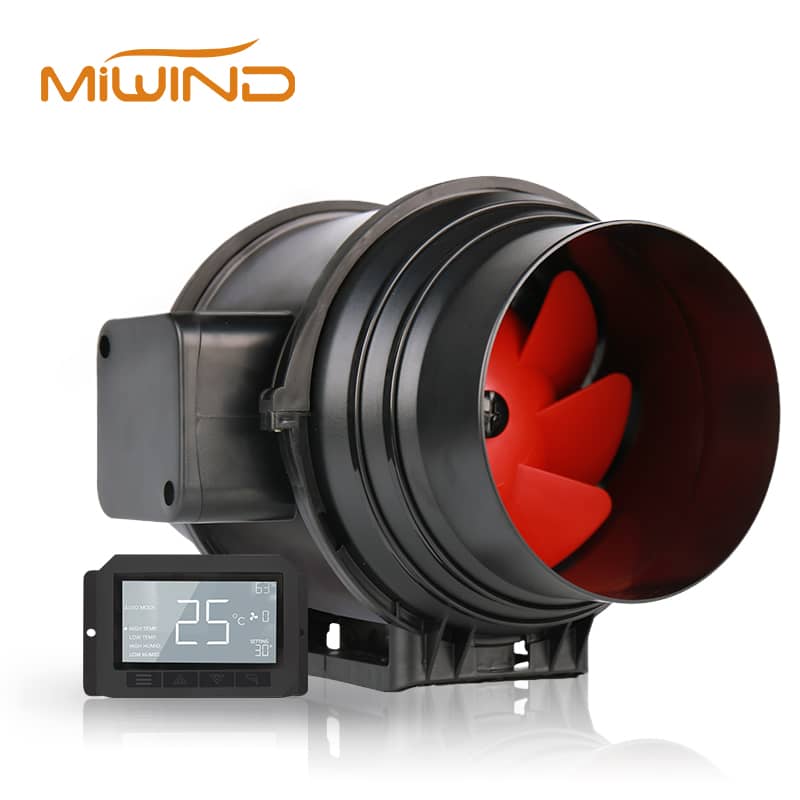
Inline duct fans are powerful ventilation tools installed within HVAC duct systems to improve airflow and efficiency. Whether in residential homes or industrial facilities, these fans help move air across long duct runs, regulate temperature, and improve indoor air quality. But what is an inline duct fan exactly, how does it work, and is it worth it? This guide answers all those questions and more.
An inline duct fan is a cylindrical, in-line ventilation device installed directly inside the ductwork. It is designed to boost airflow by pushing or pulling air through the duct system. Unlike exhaust fans mounted at the end of ducts, inline fans are placed along the duct path, allowing for more balanced and efficient air movement. This makes them suitable for both residential HVAC setups and large industrial ventilation systems.
How Do Inline Duct Fans Work?
Inline duct fans function by creating airflow within a closed ventilation system. When powered, the fan blades spin inside a cylindrical housing, pushing air through ducts to its intended destination. Depending on the installation, they can be used to extract stale air (exhaust) or supply fresh air (intake). Some models use centrifugal or mixed flow technology to maximize pressure and flow efficiency. This is ideal for long duct runs or rooms that suffer from poor ventilation.
Yes, inline duct fans are often worth the investment—especially in systems with airflow issues or long duct lengths. They provide more consistent air distribution, reduce HVAC system strain, and improve comfort and air quality. Their energy-efficient design often results in lower long-term operating costs. In industrial settings, they can help maintain regulatory air standards, while in homes, they can eliminate hot/cold spots and stale air problems.
Benefits of Using Inline Duct Fans
Inline duct fans offer numerous advantages that make them a preferred choice for enhancing airflow in various settings. Here are some key benefits:
One of the most significant benefits of inline duct fans is their ability to maximize airflow efficiency. Their cylindrical shape minimizes friction losses, allowing air to flow smoothly through the ducts. This efficiency is particularly important in systems with long duct runs or high static pressure requirements, where traditional fans may struggle to maintain adequate airflow.

Inline duct fans are designed to operate quietly due to their placement within the ductwork. Unlike standard booster fans that can be noisy when activated, inline fans are often insulated and positioned away from living spaces, significantly reducing operational noise. This feature makes them ideal for residential applications where noise sensitivity is a concern.
Inline duct fans are used in a wide range of residential, commercial, and industrial applications, including:
Residential HVAC systems – to improve airflow in rooms far from the central air handler.
Bathroom and kitchen exhaust – to remove humidity and odors more efficiently.
Grow rooms or greenhouses – to control temperature and humidity.
Factories and warehouses – to vent fumes, smoke, or dust.
Server rooms – to support continuous cooling.
Their flexibility makes them suitable for almost any air movement task inside a duct.
Inline duct fans can accommodate multiple intake points, which is particularly beneficial for larger spaces like bathrooms or multi-room setups. By using a Y junction, these fans can draw air from different locations, enhancing overall ventilation efficiency.

For applications requiring long duct runs—such as connecting a bathroom fan to a roof vent—inline duct fans outperform standard booster fans. Their design allows them to effectively transport air over greater distances without significant loss of pressure or airflow.
Many inline duct fans consume less power compared to traditional fan types while delivering higher airflow rates. This energy efficiency not only leads to lower utility bills but also contributes to a reduced carbon footprint, making them an environmentally friendly choice for both residential and commercial applications.
By effectively circulating air throughout a space, inline duct fans play a crucial role in improving indoor air quality. They help eliminate stale air and distribute fresh air evenly, reducing the concentration of indoor pollutants and allergens—a vital consideration in environments such as schools and healthcare facilities.

The compact design of inline duct fans simplifies installation within existing duct systems. Many models feature easily accessible components that facilitate maintenance tasks such as cleaning and servicing, ensuring long-term reliability and performance.
Modern inline duct fans can often be integrated with smart control systems that allow users to adjust settings based on real-time needs. This capability enhances comfort while optimizing energy usage by adjusting fan speed according to occupancy levels or specific environmental conditions.
Inline Fan: Installed inside ducts, used to push or pull air.
Duct Fan: A general term that can refer to either inline fans or end-mounted booster fans.
Exhaust Fan: Typically mounted on walls or ceilings to remove air from a room to the outside.
Inline fans are more efficient for long ductwork and offer quieter operation compared to traditional exhaust fans.
Inline duct fans offer efficient airflow, reduced energy costs, and better air quality—making them a valuable upgrade for any HVAC system. From long duct runs in homes to industrial exhaust needs, these fans are designed to work effectively across many environments. Understanding what an inline duct fan is and how it works helps you choose the right model and installation method for your space. With options now available in smart models, the future of duct ventilation looks more powerful and efficient than ever.